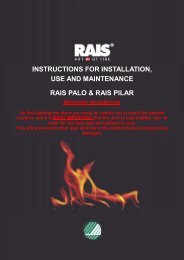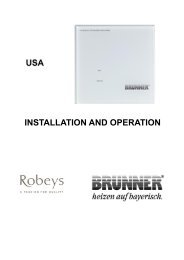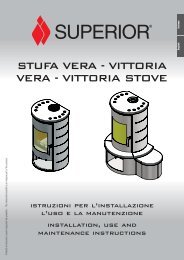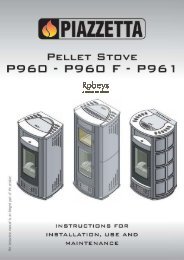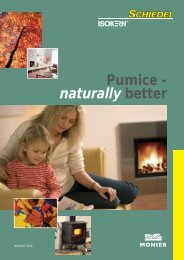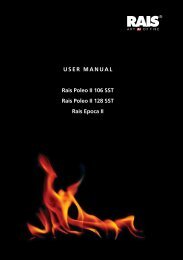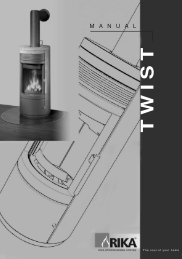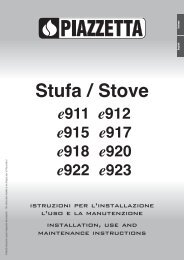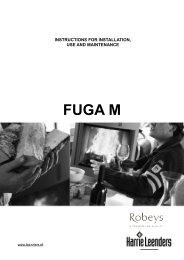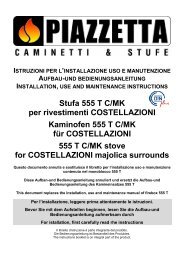instructions for installation, use and maintenance rais ... - Robeys Ltd
instructions for installation, use and maintenance rais ... - Robeys Ltd
instructions for installation, use and maintenance rais ... - Robeys Ltd
Create successful ePaper yourself
Turn your PDF publications into a flip-book with our unique Google optimized e-Paper software.
ENGLISHRAIS manual <strong>for</strong> Rais Poleo <strong>and</strong> Rais EpocaConvectionRais stoves are convection stoves. This means that the stove’s back <strong>and</strong> side panels arenot overheated. Convection means that there is a circulation of air, which ensures thatthe heat is distributed more evenly throughout the entire room. The cold air is sucked in atthe base of the stove <strong>and</strong> up through the convection channel, which runs along thestove’s combustion chamber. The heated air comes out at the top of the stove, whichensures a circulation of warm air throughout the room.The stoves are equipped with cool door h<strong>and</strong>les a Rais special feature which meansyou could almost do away with gloves. Be aware, however, that all exterior surfacesbecome hot during <strong>use</strong> so take extreme care.ChimneyIn order <strong>for</strong> the stove to per<strong>for</strong>m satisfactorily the chimney height must be sufficient toensure an adequate draught of approximately 15 Pa so as to clear the products ofcombustion <strong>and</strong> prevent smoke problems into the room.NOTE: A chimney height of not less than 4.5 metres measured vertically from the outlet ofthe stove to the top of the chimney should be satisfactory. Alternatively the calculationprocedure given in EN 133841 may be <strong>use</strong>d as the basis <strong>for</strong> deciding whether aparticular chimney design will provide sufficient draught.The outlet from the chimney should be above the roof of the building in accordance withthe provisions of Building Regulations Approved Document J.If <strong>installation</strong> is into an existing chimney then it must be sound <strong>and</strong> have no cracks orother faults which might allow fumes into the ho<strong>use</strong>. Older properties, especially, mayhave chimney faults or the cross section may be too large i.e. more than 230 mm x 230mm. Remedial action should be taken, if required, seeking expert advice, if necessary. If itis found necessary to line the chimney then a flue liner suitable <strong>for</strong> solid fuel must be <strong>use</strong>din accordance with Building Regulations Approved Document J.Any existing chimney must be clear of obstruction <strong>and</strong> have been swept cleanimmediately be<strong>for</strong>e <strong>installation</strong> of the stove. If the stove is fitted in place of an open firethen the chimney should be swept one month after <strong>installation</strong> to clear any soot fallswhich may have occurred due to the difference in combustion between the stove <strong>and</strong> theopen fire.If there is no existing chimney then any new system must be to the designationdescribed above <strong>and</strong> in accordance with Building Regulations Approved Document J.A single wall metal fluepipe is suitable <strong>for</strong> connecting the stove to the chimney but is notsuitable <strong>for</strong> <strong>use</strong> as the complete chimney. The chimney <strong>and</strong> connecting fluepipe musthave a minimum diameter of 150 mm <strong>and</strong> its dimension should be not less than the sizeof the outlet socket of the stove.7



